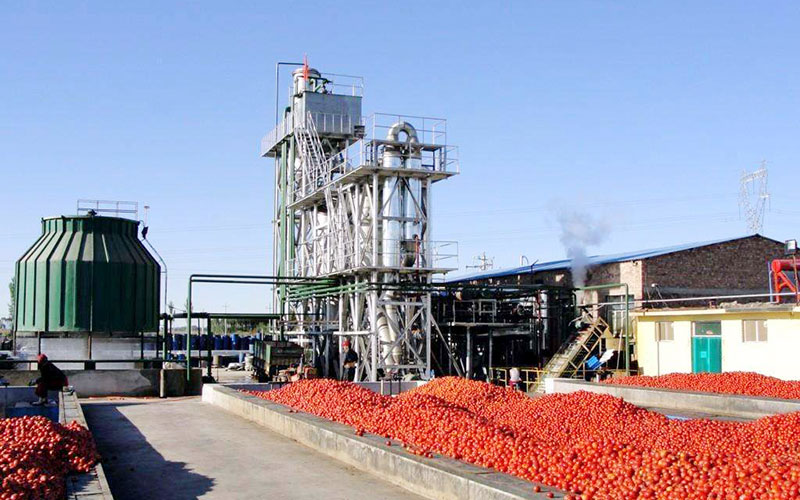Industrial tomato paste manufacturing transforms perishable, high-moisture tomatoes into a shelf-stable, intensely flavored concentrate through precisely engineered processes. The tomato paste production line integrates specialized machinery that addresses the fruit’s biochemical properties—high enzymatic sensitivity, pectin vulnerability, and low initial solids (4.0–5.5°Brix)—to achieve concentrations of 28–38°Brix while preserving color, viscosity, and nutrition. Here’s how factories accomplish this at scale.
Stage 1: Raw Material Handling – Selecting Tomatoes for Optimal Solids & Viscosity
Tomatoes must meet strict criteria: ≥90% maturity, deep red color, and solids content >4.0°Brix to ensure efficient concentration and end-product texture. The line begins with:
Hydraulic flume transport: Uses water currents to move tomatoes gently, minimizing bruising.
Roller-conveyor cleaning: Removes 95%+ of soil/sand via high-pressure sprays and bubbling soak tanks.
Sorting: reject green, rotten, or defective fruits to prevent enzymatic degradation.
Why it matters: Underripe tomatoes reduce lycopene content and increase acidity, compromising paste quality.
Stage 2: Pre-Treatment – Enzymatic Deactivation & Pectin Preservation
Tomatoes’ pectin-destroying enzymes (polygalacturonase) activate within minutes of crushing. To halt this:
Crushing & de-seeding: High-speed blades pulp tomatoes while centrifugal separators remove seeds (which impart bitterness if broken).
Flash heating (85–90°C): Inactivates enzymes within 2–4 seconds via tubular heat exchangers, preserving pectin for ideal viscosity.
Critical control point: Temperatures >95°C degrade fructose, causing caramelization and browning.
Stage 3: Pulping & Concentration – Maximizing Yield & Color Retention
Double-pass refining extracts maximum pulp:
Coarse pulping (1.5–2.0mm screens): Removes skin and residual seeds.
Fine pulping (0.6–0.8mm screens + variable-frequency drives): Achieves smooth texture without fiber fragments.
Vacuum concentration then reduces water content:
Forced-circulation evaporators: Operate at ≤70°C under -0.08MPa vacuum to prevent thermal damage to lycopene and vitamins.
Brix monitoring: In-line refractometers automate density control (e.g., 28–30°Brix for retail paste; 36–38°Brix for bulk export).
Efficiency tech: Secondary steam recovery cuts energy use by 30% vs. open-vat boiling.
Stage 4: Sterilization & Aseptic Packaging – Ensuring Safety & Shelf Life
High-temperature-short-time (HTST) sterilization is critical:
Tubular or plate heat exchangers: Heat paste to 100–121°C for 20–30 seconds, killing microbes while minimizing nutrient loss.
Packaging flexibility caters to diverse markets:
Bulk: 220L aseptic bags-in-drums for food processors (common in industrial lines).
Retail: Glass jars, PET bottles, or sachets (70g–500g) filled on servo-driven machines at 50–200 packs/minute.
Key innovation: Four-layer co-current sterilizers prevent fouling—a major cause of downtime in older systems.
Production Line Variations: Tailoring for Scale & Product Type
| Line Type | Fresh Tomato Capacity | Key Equipment | Best For |
|---|---|---|---|
| Small-scale | 25–500 kg/hour | Semi-auto fillers, single-effect evaporators | Startups, regional brands |
| Mid-scale | 1–10 tons/hour | Automated PLC controls, dual-effect evaporators | Retail suppliers |
| Industrial | 150–1500 tons/day | CIP systems, triple-effect evaporators, robotic palletizers | Export-focused factories |
Note: Hybrid lines can also process onion, pepper, or fruit pastes by swapping pulping screens.
Why Tomato’s Biochemistry Dictates Factory Design
Pectin sensitivity → Requires ultra-fast enzyme deactivation.
High water content (94–95%) → Demands multi-stage vacuum concentration for efficiency.
Thermolabile nutrients → Necessitates low-temp sterilization (<125°C).
Viscosity variability → Adjustable pulping/refining avoids texture defects.
Conclusion
Industrial tomato paste manufacturing hinges on overcoming tomatoes’ unique biochemical challenges: enzymatic sensitivity, pectin vulnerability, and high water content. Success demands an integrated line with specialized equipment at every stage—from gentle handling and ultra-fast enzyme deactivation (85-90°C flash heating), through low-temperature vacuum concentration (<70°C) preserving nutrients, to HTST sterilization (100-121°C) ensuring safety.
The right line configuration—tailored to your scale (small startup to industrial 1500 tons/day) and target Brix (28-38°)—directly impacts quality, yield, and efficiency. Modern solutions like multi-effect evaporators (cutting energy by 30%) and fouling-resistant sterilizers are critical for profitability.
Ready to Optimize Your Tomato Paste Line?
Unlock Peak Efficiency & Quality: Our precision-engineered equipment—from high-speed crushers and vacuum evaporators to aseptic fillers—is designed specifically for tomato paste’s demands.
Get Tailored Solutions Now!
Leave a quick comment below with your:
- Target Capacity (e.g., tons/hour)
- Desired Final Brix Level
- Packaging Format (e.g., bulk BIB, glass jars)
We’ll immediately send you:
- Detailed specs for the optimal equipment.
- Efficiency & yield projections for your setup.
- Custom line configuration options.
Don’t settle for generic equipment. Get the precise technology for superior tomato paste. Comment now and start optimizing!





